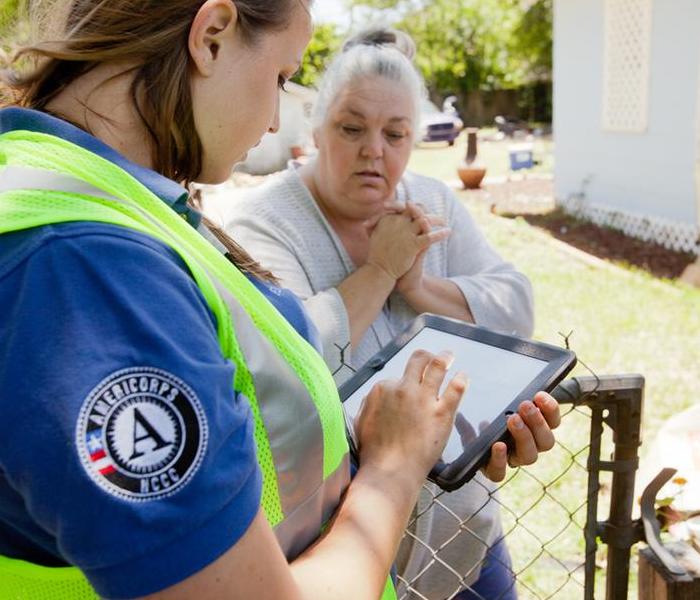Does Your Family Have a Disaster Plan?
12/9/2013 (Permalink)
 FL, May 15, 2014 -- Disaster Survivor Assistance Team (DSAT) member Marie Orechoff checks on the FEMA application status of Toni Talley in Pensacola
FL, May 15, 2014 -- Disaster Survivor Assistance Team (DSAT) member Marie Orechoff checks on the FEMA application status of Toni Talley in Pensacola
Disasters can happen quickly and most times without a warning. You never know when basic services, such as gas, electricity, water or telephones will be cut off. Preparing and planning must prepare your family for this. Knowing what to do is your best protection and your responsibility. Here are some ways to help to prepare your family in times of a disaster.
Learn what disasters and emergencies that have the possibility to occur in your area.
Know what to prepare for by calling your local emergency management office or American Red Cross chapter. Learn what disasters can happen rather it’s manmade or natural and found out what are the best ways to prepare for each one. Found out what public warning systems your community has and what they sound like. Learn the disaster plans at your workplace, school, daycare, or other places where your family may spend a lot of time.
Create and Implement a Family Disaster Plan.
Set up a family meeting to discuss what plan needs to be in place and the importance of the plan. Keep the plan simple enough for everybody to understand and follow. This is a team effort and everybody must know what part they play. Explain the dangers of the type of disasters that may occur in your area. Everybody should know what to do in each instance. By discussing everything before disaster strikes, it will allow everyone to be calm and execute the plan.
You then need to make sure you have two meeting places for your family incase everyone is not together. They should be familiar with the locations and know the address. Right outside of your home in case of a sudden emergency or outside of your neighborhood in case you can’t return home or are asked to leave your neighborhood. Separation will play a big factor if the disaster occurs during the times parents are at work and the children are at school. You need to have a plan of getting everybody together.
You should set a primary person outside of the disaster area as your family’s primary contact. Family members should call the contact and tell him or her where they are. Everyone must know the contact’s name, address, and phone number. Found out about shelters in the contact’s area or arrange to stay with that contact if possible. Plan your escape routes and get familiar with them. You should always have alternate escape routes in place.
If you have pets plan on how you will care for them during a disaster. Unless your pet(s) are service animals they are not permitted to be in places where food is served, according to many local health department regulations. Plan where you would take your pets if you had to go to a public shelter where they are not permitted. Make sure you post all important phone numbers and emergency numbers next to all phones in your home.
Practice makes perfect
Once you have your plan implemented it is important you practice it as a family so it will become second hand when the time comes. You may need to modify and change the plan a little over a period of time. Conducting actual drills with your family will help them be better prepared. You should drive all evacuation routes that is designated in your plan. This should be performed at least twice a year. Make sure to keep stored food and water. Also restock after six months to keep goods refreshed. Check your smoke alarms every month and run test on them to insure they are working well. Replace batteries if needed. The National Fire Protection Association and the U.S. Consumer Products Safety Commission has recommended that you change out your fire alarms every ten years. Also make sure to test all fire extinguishers.
SERVPRO of Flagler County - Palm Coast Florida is locally owned and operated and serves Palm Coast, Flagler Beach, Hammock Dunes, Beverly Beach, Bunnell, Marineland, Hammock, Hammock Beach and the surrounding North East Florida communities.
SERVPRO of Flagler – Palm Coast Fl.’s fully certified water removal staff can perform a complete damage assessment to your home of office, and then recommend and follow the industries standards to get your water removal restoration repaired properly available 24 hours a day
Older Posts
What to look for in a restoration company
What to do when your home floods
What to do when you have a water damage
Hot Water Heater Leak or Failure
Preventing mold growth after a water loss
mold-all too common after flooding
SERVPRO of Flagler County – Palm Coast Services
Water Damage Fire Damage Disaster, storm and flood damage Mold Damage





 24/7 Emergency Service
24/7 Emergency Service